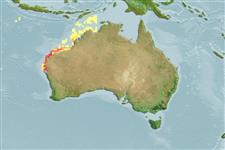Environment: milieu / climate zone / depth range / distribution range
पारिस्थितिकी
समुद्री; खारा ड़िमरसल. Subtropical; - 26°S
Eastern Indian Ocean: Endemic to southern Australia.
आकार / वज़न / Age
Maturity: Lm ? range ? - ? cm
Max length : 28.0 cm TL पुल्लिंग / अलिंग; (Ref. 33839)
Short description
पहचान कुंजी | आकृति विज्ञान | मौरफोमैटरिक्स
पृष्ठीय रीढ़ (सम्पूर्ण) : 12; पृष्ठीय सौफट रेज़ (सम्पूर्ण) : 9; गुदा कांटा: 3; ऐनल सौफट रेज़: 7.
An omnivore found in inshore areas (Ref. 7300). Eggs are guarded and fanned by the male parent (Ref. 205).
Life cycle and mating behavior
Maturities | पुनरुत्पत्ति | Spawnings | Egg(s) | Fecundities | लार्वा
Eggs are guarded and fanned by the male parent (Ref. 205).
Paxton, J.R., D.F. Hoese, G.R. Allen and J.E. Hanley, 1989. Pisces. Petromyzontidae to Carangidae. Zoological Catalogue of Australia, Vol. 7. Australian Government Publishing Service, Canberra, 665 p. (Ref. 7300)
IUCN Red List Status (Ref. 130435)
Threat to humans
Harmless
Human uses
मात्स्यिकी: कोई रुचि बग़ैर
साधन
Special reports
Download XML
इंटरनेट स्रोत
Estimates based on models
Preferred temperature (Ref.
123201): 24.2 - 28.6, mean 27.4 °C (based on 74 cells).
Phylogenetic diversity index (Ref.
82804): PD
50 = 0.6250 [Uniqueness, from 0.5 = low to 2.0 = high].
Bayesian length-weight: a=0.00479 (0.00188 - 0.01218), b=3.09 (2.87 - 3.31), in cm total length, based on LWR estimates for this (Sub)family-body shape (Ref.
93245).
Trophic level (Ref.
69278): 3.0 ±0.4 se; based on size and trophs of closest relatives
Generation time: 2.6 ( na - na) years. Estimated as median ln(3)/K based on 2
growth studies.
लौटाव (Ref.
120179): ऊंचा, न्यूनतम जनसंख्या दुगनी समय अवलागत 15 महीने। (Preliminary K or Fecundity.).
Fishing Vulnerability (Ref.
59153): Low to moderate vulnerability (28 of 100).
Nutrients (Ref.
124155): Calcium = 119 [72, 226] mg/100g; Iron = 1.08 [0.69, 1.77] mg/100g; Protein = 18.8 [18.0, 19.6] %; Omega3 = 0.265 [0.159, 0.437] g/100g; Selenium = 24 [13, 45] μg/100g; VitaminA = 13.6 [5.7, 32.3] μg/100g; Zinc = 1.01 [0.73, 1.38] mg/100g (wet weight);
